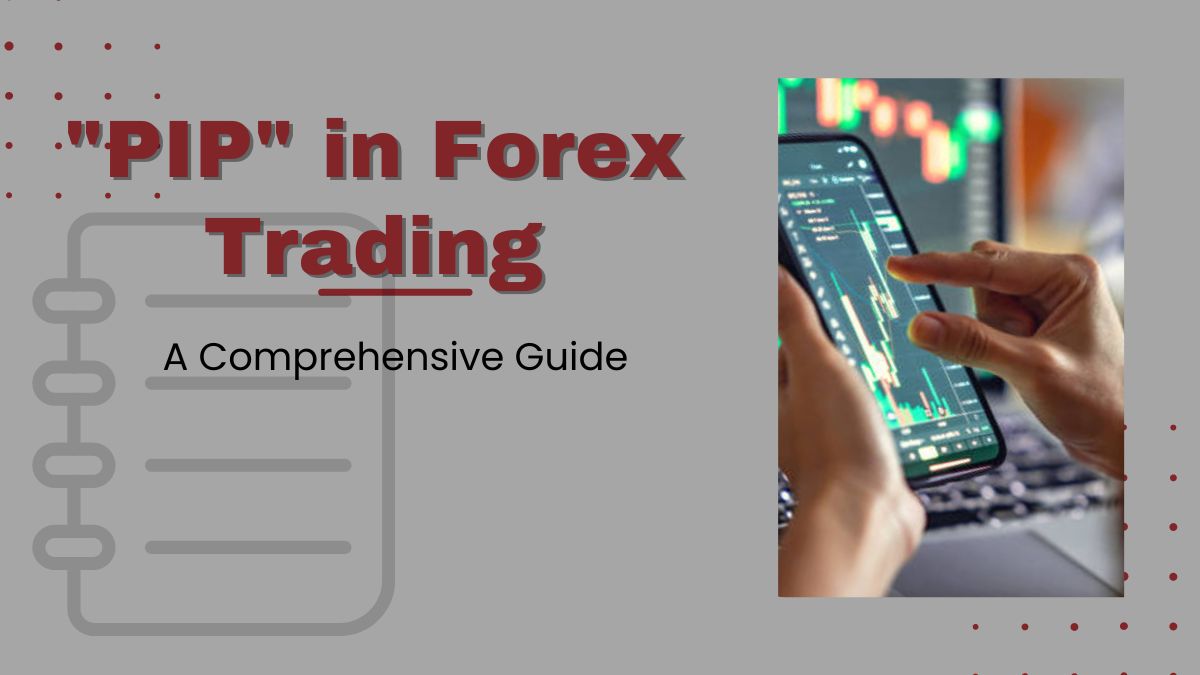Demystifying the Term “PIP” in Forex Trading: A Comprehensive Guide

Welcome to our comprehensive guide on demystifying the term “PIP” in forex trading! If you’re new to the world of foreign exchange or even a seasoned trader looking for clarity, this blog post is here to unravel all aspects of PIPs. Stay tuned as we break down this commonly used abbreviation, explain its significance in measuring currency movement, and equip you with invaluable insights that will enhance your trading strategies like never before. Whether you’ve heard the term tossed around or simply want to sharpen your knowledge, buckle up as we dive into the ultimate exploration of PIPs in forex trading.
Table of Contents
What is a PIP in Forex Trading?
When you first begin trading in the foreign exchange (forex) market, you may come across unfamiliar words and phrases. One term that you’re likely to hear often is “pip.” What is a pip?
In the forex market, currencies are quoted in pairs. For example, if the EUR/USD pair is quoted as 1.1850, that means one euro equals 1.1850 U.S. dollars. The bid price is always the lower value of the two currencies, while the ask price is always the higher value. In this case, the bid price would be 1.1840 and the ask price would be 1.1860—a spread of 20 pips.
A pip is a unit of measurement for changes in a currency pair’s rate. It tells you how much one currency has increased or decreased in value relative to another currency. For most major currency pairs, one pip is equal to 0.0001 of the quote currency.* So in our example above, if the EUR/USD pair increases from 1.1850 to 1.1851—one pip—then one euro has increased in value by 0.0001 USD relative to the dollar’s current value.*
Pips can also be represented as a percentage of an account’s total equity, known as “pip value.” For instance, if your account equity is $10,000 and you gain 10 pips on a trade, your new account equity would be $ 10,010. In this case, each pip would be worth $1.
*Note: This example applies to the EUR/USD currency pair only. The value of a pip may vary depending on the currency pair being traded.
What Does PIP Stand For?
PIP stands for “price interest point” and is the smallest unit of price change in forex trading. A single pip is equivalent to 0.0001 of a dollar, or 1/100th of a percent. In other words, when the price of a currency pair moves up or down by one pip, it means that the value of the currency has changed by 0.0001 against the other currency in the pair.
PIP is also sometimes used as an acronym for “percentage in point,” which is another way of expressing the concept of a pip. In this case, one pip would be equal to 0.01% (one basis point). However, “pip” is more commonly used to refer to the actual unit of price change.
Knowing how pips work is important for two reasons: first, because pips are the basis for calculating profits and losses in forex trading; and second, because pips are used as a unit of measure when quoting currencies. When you see a currency quoted at 1.2500, for example, this means that one euro (the ‘base currency’) is worth 1.25 U.S. dollars (the ‘quote currency’). If the price then goes up by one pip to 1.2505, this means that each euro is now worth 1.2505 dollars – five pips more than before.
To summarize, PIP stands for “price interest point” and is a unit of measurement used to express the smallest change in price in forex trading. PIPs are also sometimes expressed as a percentage (such as 0.01% or one basis point). Knowing how pips work is important in order to understand both the profits and losses associated with trading as well as the currency quotation convention.
Calculating PIP Values
When trading forex, it is important to understand the term “pip.” A pip is the smallest unit of measurement in forex. Pip values can vary depending on the currency pair you are trading, but usually a pip is worth $0.0001.
To calculate the value of a pip, you need to know the size of your trade in units and the current exchange rate. For example, if you are buying 100,000 units of EUR/USD and the current exchange rate is 1.2350, then each pip is worth $12.35 (100,000 x 0.0001 = $12.35).
If you want to calculate the dollar value of a pip for a different currency pair, you can use our Pip Value Calculator.
The Different Types of Currency in Forex Trading
When it comes to forex trading, there are a few key terms that are essential to understand. One of those terms is “pip.” In this blog post, we’ll demystify the term pip and explain what it is in relation to forex trading.
A pip is the smallest unit of price movement in the forex market. In most currency pairs, a pip is equal to 0.0001 of a cent. For example, if the EUR/USD currency pair moves from 1.2345 to 1.2346, that’s a one-pip move. In currency pairs that include the Japanese Yen (JPY) as the quote currency, a pip is equal to 0.01 of a yen.
Most brokers display the value of a pip in both USD and JPY so that traders can easily see how much they stand to gain or lose on each trade. For example, if you buy 10,000 units of EUR/USD at 1.2350 and then sell at 1.2360, you would make $100 (or 10 pips). Similarly, if you bought 10,000 units of USD/JPY at 109.50 and then sold at 109.60, you would also make $100 (or 10 pips).
Pips are an important part of forex trading because they represent your potential profit or loss on each trade. If you’re only looking to make very small profits on each trade, you ‘ll want to look for pairs with very small pip values. However, if you’re looking to make bigger profits, then you’ll need to look for pairs that have larger pip values. It’s important to familiarize yourself with the different currencies and their respective pip values so that you can choose the best pairs for your trading strategy.
The Role of PIP in Profiting from Forex Trading
In forex trading, “PIP” is an acronym for “percentage in points” or “price interest point.” A PIP is the smallest unit of change in a currency pair. In most pairs, a PIP is equal to 0.0001 (one basis point). For example, if the EUR/USD moves from 1.1750 to 1.1751, that 0.0001 USD increase in value is one PIP.
PIPs are used to calculate profits and losses in currency trading. When you enter a trade, you typically quote a PIP spread, which is the difference between the bid and ask prices of the currency pair. For example, if the bid price of EUR/USD is 1.1750 and the ask price is 1.1751, the spread would be 1 PIP.
When you close out a trade, your profit or loss is typically calculated in PIPs. For example, if you bought EUR/USD at 1.1750 and sold it at 1.1751, your profit would be 1 PIP. Alternatively, if you sold EUR/USD at 1.1750 and bought it back at 1.1751, your loss would be 1 PIP.
Pips can also be used to calculate your risk exposure in a currency trade. Most forex brokers will quote a standard lot size of 100,000 units of currency (known as a mini lot), 10,000 units ( known as a micro lot), or 1,000 units (known as a nano lot). Your risk exposure is calculated by multiplying the lot size by the PIP spread. Therefore, if you buy EUR/USD at 1.1750 and the PIP spread is 1, your risk exposure would be 100,000 x 0.0001 = 10 USD.
Overall, PIPs are an important part of forex trading because they help traders calculate their profits and losses, as well as their risk exposure in a currency pair.

Strategies to Help Manage Risk with PIPs
PIPs, or price interest points, are the smallest unit of measure in forex trading. A one-pip movement is equivalent to a change of 0.0001 in most currency pairs. PIPs are used to quote prices and calculate profits and losses.
Most brokers allow traders to choose the amount of risk they want to take on each trade. This is typically expressed as a percentage of the account’s equity, or margin. For example, if a trader has an account with $10,000 and sets the risk per trade at 1%, then they are risking $100 per trade.
There are a number of strategies that traders can use to help manage risk when trading with PIPs:
- Set a stop-loss order: this is an order that will automatically close your position if the market moves against you by a certain number of pips. This helps limit your losses if the market goes against you.
- Use limit orders: these are orders that will only execute at a certain price. This can help you avoid getting into trades that are too risky, or missing out on good opportunities if the market moves too fast.
- Manage your position size: this means managing the number of lots or units you trade so that your overall risk is limited to an acceptable level. For example, if you have a $10,000 account and you’re comfortable risking 1% per trade, then you can trade up to a maximum of 1 lot or 100,000 units.
- Use the carry trade: this is a strategy where you buy a currency with a higher interest rate and simultaneously sell a currency with a lower interest rate. This allows you to take advantage of the differentials in interest rates while keeping your risks under control.
- Use hedging strategies: these are strategies that involve taking offsetting positions so that if one position moves against you, the other will limit your losses. For example, if you were long EUR/USD at 1.1200 and short USD/JPY at 111.00, then if EUR/USD falls you can expect USD/JPY to rise by the same amount, which would help limit your losses.
- Set realistic profit targets: this means having a plan for when to take profits and when to exit losing trades. If you have a target profit in mind then it can help focus your attention on finding points of entry and managing trades more effectively.
- Be patient and disciplined: most traders who succeed over the long term do so because they manage their risk carefully, don’t chase losses, and stay disciplined even when things don’t seem to be going their way. Stick to your strategy, take profits when they come, and cut your losses short before they get out of hand.
By managing risk with PIPs, traders can help ensure that their trades are profitable and minimize losses. With patience and discipline, traders can maximize their chances of success in the forex market.
How to Use Leverage Wisely for Maximum Profits?
Leverage is a common tool that investors use to magnify the returns on their investment. It allows you to control a large amount of money with a relatively small amount of your own capital.
However, it’s important to use leverage wisely, as it can also magnify your losses.
Here are a few tips on how to use leverage wisely for maximum profits in forex trading:
- Know Your Limits: Before using leverage, it’s important to know your limits. How much capital are you willing to risk? How much can you afford to lose? Knowing your limits will help you avoid overleveraging your account and making costly mistakes.
- Use a Risk-Management Strategy: When using leverage, it’s important to have a risk-management strategy in place. This will help you limit your losses if the market moves against you. There are many different risk-management strategies that traders use, so find one that works best for you and stick with it.
- Don’t Overtrade Your Account: Overtrading with leverage can be dangerous. Don’t make the mistake of trading beyond your means or taking on too much risk. Always make sure that you are comfortable with the amount of leverage you are using and never take on more than you can afford to lose.
- Utilize Stop-Loss Orders: Another way to protect yourself from excessive losses is to use stop-loss orders. These orders will limit your exposure to a certain amount of risk, so be sure to set them up as part of your risk-management strategy.
- Be Patient and Disciplined: Finally, it’s important to remain patient and disciplined when trading with leverage. Don’t let emotions drive your decisions – instead, focus on the market analysis and stick with your trading plan even when things don’t go as expected.
By following these tips, you should be able to use leverage wisely and maximize your profits.
Conclusion: Must Know Facts About PIPs in Forex Trading
A forex Pip is a very small measure of change in a currency pair, typically measuring one hundredth of a percent. In practical terms, pips are used to quantify the amount of risk taken on by a trader or investor, as well as profits or losses. A standard lot size in forex is equal to 100,000 units of the base currency, and a pip is usually equal to the fourth decimal place of this currency. For example, if the EUR/USD moves from 1.1050 to 1.1051, that is one pip of movement.






